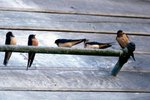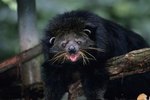
Omnivores are survivalists in the purest sense. With the ability to eat a variety of foods, the omnivore can live in a number of environments. What's also interesting is that many animals that are thought to be carnivorous -- such as wolves -- are actually omnivores. While these animals do have the ability to eat a variety of foods, some will prefer meat over vegetables and vice versa.
Definition
An omnivore is a species that eats both plants and animals. Omnivores can be a tiny fly that eats both rotting fruit and animal carcases, or it can be a grizzly bear that eats fish and berries. Some omnivorous mammals have a variety of teeth that allow for eating different foods. For example, they may have canine teeth for tearing meat and molars for grinding plant material.
Examples
People might believe a species eats only meat or plant material, but there are more omnivores than they think. Examples include birds who eat seeds and fruit, but also eat insects. Another example is the canine who prefers to eat meat, but will also eat fruits and vegetables. Some omnivores fall into the scavenger category, meaning they eat what they can find -- such as the opossum, which eats insects and whatever can be found in the neighborhood trash cans. Omnivores can be found in all animal kingdoms. Fish, reptiles, birds, mammals and insects are all known for having species that eat both meat and plant material.
Balanced Diets
You may think this leads to a balanced diet -- like the menu for a typical omnivorous human -- but most omnivores eat one food over the other. For example, juvenile bearded dragons should eat 80-percent protein and 20-percent plant material, while those percentages are reversed in their adult years. Most omnivorous species will eat mostly protein or mostly vegetation. Another example would be the gray squirrel, which eats mostly nuts, but will also eat insects and even small birds.
Benefits
There are many benefits in being an omnivore. Omnivorous animals are better able to survive due their ability to eat both animals and plants. This means that if one food source is scarce, they can eat the other. It may not be their favorite food, but it will keep them alive. Another benefit is that omnivores can be opportunistic, especially scavengers. Scavengers can eat from dead animals, raid trash receptacles or consume half-eaten fruit that another animal has left behind.
References
Photo Credits
-
Jupiterimages/Photos.com/Getty Images
Writer Bio
Amy Brantley has been a writer since 2006, contributing to numerous online publications. She specializes in business, finance, food, decorating and pets.



